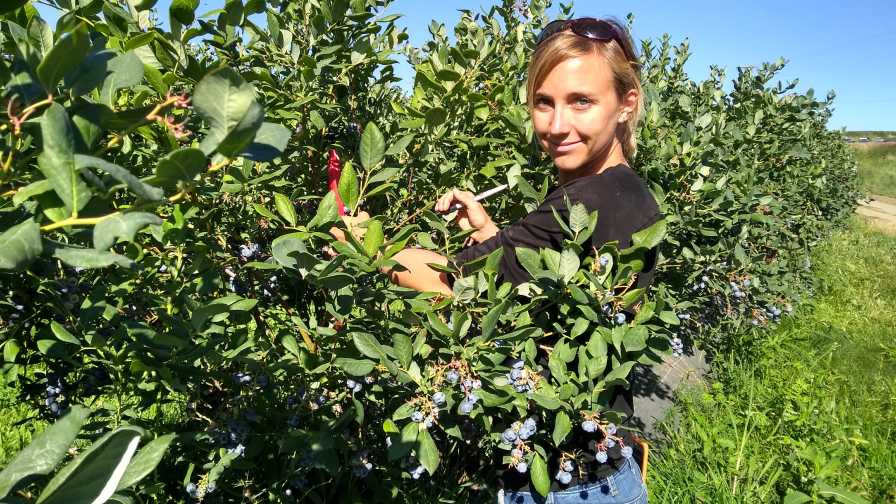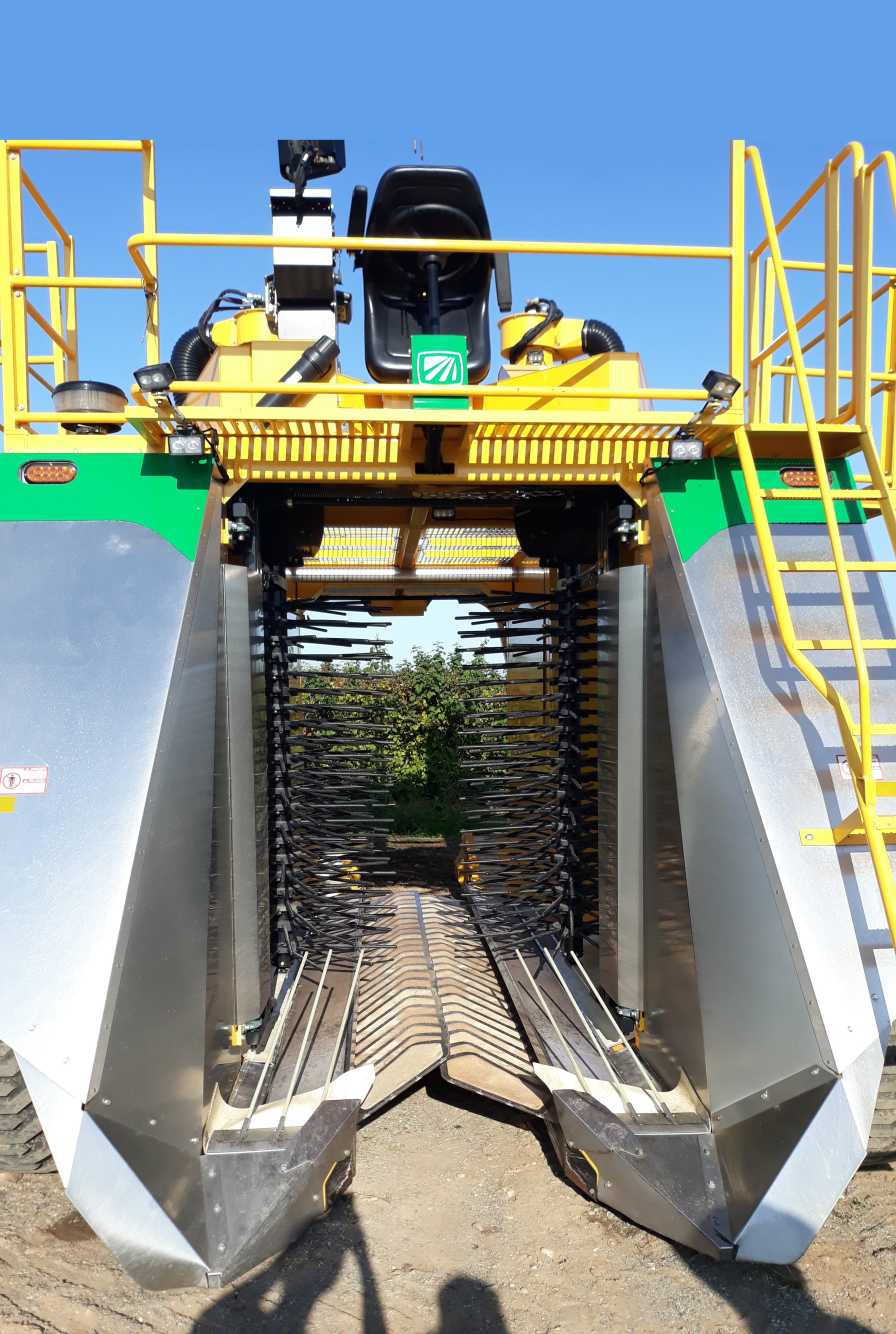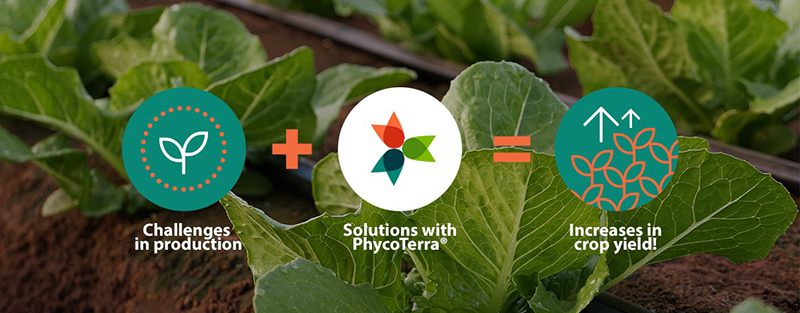What’s the Secret? Machine Harvesting of Blueberries Is Taking Off

Lisa DeVetter, Washington State University Associate Professor, Berry Crops, is working on a guide in which she outlines the key steps in machine harvesting of fresh-market blueberries.
Photo courtesy of Washington State University
It’s no secret that blueberry planting has been rocketing upward around the world, and the U.S. is no exception. In 2019, the most recent figures available from the USDA National Agricultural Statistics Service, 102,700 acres were harvested in the U.S., up 15% in a single year. Utilized production totaled 673 million pounds, leaping 21% from 2018, showing at least in part how much more efficient growers are getting with improved varieties. In 2009, total acreage was just 64,270, meaning that in a single decade the area harvested in the U.S. shot up 60%.
Of the 2019 total utilized production, the amounts that went for fresh market and processing were fairly close, 373 million pounds for the fresh market and 300 million pounds for processing. But prices were very different, with fresh market berries fetching four times as much: $2.03 per pound, compared with a processing price of just 50 cents
a pound.
With such an obvious incentive to grow for fresh market, it’s no surprise growers who traditionally have grown for processing are increasingly trying to grow for the fresh market, says Lisa DeVetter, Washington State University Associate Professor, Berry Crops. But one obvious problem is that growing for fresh market obviously requires higher quality fruit, and has been traditionally picked by hand.
In the Pacific Northwest, where the crop has boomed in recent years, that would mean all hands on deck. Even then, with the decline in available farm labor in the Pacific Northwest — just as growers are feeling elsewhere — it would be difficult.
“If you had to hand-harvest all that (fresh market) fruit,” she says flatly, “you’d struggle to do it.”
THE AGE OF AUTOMATION
If there aren’t enough hands, that means picking with machines, and the percentage of growers who are machine harvesting blueberries for fresh market continues to grow.
“It’s been increasing rapidly,” DeVetter says. “It used to be 10 to 20% about 20 years ago. Then, when labor costs started increasing, growers got motivated. By 2016, about 33% of fresh-market fruit was machine-harvested according to national surveys. Then we had COVID, and it might be approaching 40 to 50% here, though it will be much higher by 2025.”
That tremendous growth has come through improvements in machine harvesters that make picking quality fruit for fresh market possible, a movement that resurged in 2013, she says. The following year, a USDA Specialty Crop Research Initiative was launched by University of Georgia Engineering Professor Charlie Li, an expert on sensor technology. Oxbo International Corp. of Lynden, WA, which manufactures harvesters for several crops, was involved on the project from the beginning, says the company’s Global Market Manager, Fruit, Kathryn Van Weerdhuizen.
The key to the project, Van Weerdhuizen says, was the Berry Impact Recording Device (BIRD). The size of a blueberry, the BIRD could go through the harvest process and help researchers understand the exact force blueberries encounter.
“We could then understand a G-force safe zone for blueberries. The first drop is the worst drop because the fruit falls from the plant to the harvester. It is a key step where the berry can bruise,” she says.
Unfortunately, that height turned out to be rather short. The G-force experienced by a blueberry dropped onto a hard surface will induce bruising once the height exceeds just 12 inches, and blueberry plants can be
6 feet tall. The machines went through several generations, she says, and the researchers tried all sorts of surfaces looking for the right material. In 2018, the second generation of machines was developed. These first soft-surfaced machines utilized neoprene, which worked well but was too susceptible to wear.
“The problem was finding a material for the catch plate, which until then had been made of Lexan, that would be soft enough but would also hold up to wear,” Van Weerdhuizen says of all the lab testing. “People tried gluing all sorts of soft surfaces onto hard surfaces, and that just didn’t work.”

The Oxbo 7440 harvester features the SoftSurface, which includes modified catcher plates with a food-grade, elastomeric polymer and soft intermediate catch frames suspended above the catch plates and conveyor belts.
Photo by Lisa DeVetter
ON-FARM TRIALS
In 2019, Oxbo took to the field to test the third generation of soft surfaces on two units, the 7440, a top-load model, and 8040, a rear-load unit. They followed the harvest that year, starting in Florida, then moving up the coast to New Jersey. Then they tried the soft-surface units on the West Coast.
“Using them in the field and lab research are two different things, and Gen 3 wasn’t perfect either,” she says.
But the fourth generation that came out just last year proved to be the charm, says Van Weerdhuizen. Oxbo is using a food-safe elastomeric polymer — she says she can’t be more specific about the material because it is patent-pending — that is integral to the catch plate and a long, suspended panel that takes the first, key berry impact. They sold four of the units equipped with the fresh kit last year.
“We and the customers were impressed with the longevity of the material,” she says, “and you can pop them out if moving between fresh and processed fruit.”
Talking to these customers has proved difficult, however. All growers contacted by American Fruit Grower® and Western Fruit Grower® magazines were mum on the topic, a fact that didn’t come as a surprise to either DeVetter or Van Weerdhuizen.
“People who machine harvest for fresh don’t talk publicly about it,” Van Weerdhuizen says. “There can be a bias among fruit marketers — at the end of the day their brand is on the product — and they want to make sure it’s high quality.”
There’s also the fact that some packers have gotten poor-quality fruit that’s been machine-harvested because some growers just don’t do it the right way.
“So if the growers who do it the right way have any secrets, they don’t want to share what they are doing,” she says. “There are a lot of good farmers out there who have invested capital and effort in what they’re doing, and they’re like good, sharp businessmen everywhere,” she says. “You have to keep up that cold chain, which requires putting a lot of pieces together to do a really a good job.”
ONE GROWER’S VIEW
One grower did agree to comment, but only in writing and only if he remains anonymous. He states that his company has utilized Oxbo’s harvester with the SoftSurface for one season.
“Until this time, we believed that machine picking for fresh was not yet a viable form of fresh harvesting large-scale,” he writes. “We value quality a lot, and we saw too much bruising on the traditional harvesters. However, when we tried the Oxbo with the SoftSurface installed, the overall quality changed drastically. The heavy bruising was cut in half, which by itself was a game changer, but also the light bruising of the remaining fruit was eliminated.”
The grower continues: “Often when you machine pick, there are bruised berries that are very soft, which is easy to sort out, and the remaining berries might be mostly solid but a little soft. This fresh kit helped make the remaining berries as firm as hand-picked. This did not however solve all the problems overnight. Machine-harvesting for fresh requires good harvest timing, correct picking temperatures, and correct beater speed/machine speed per variety. This is why we have chosen to dip our toes in this form of harvesting and verifying that every pound we bring in has quality at least on par with hand picked.
“Occasionally, it is even better than hand picked because you can harvest when the temperature is lower than a traditional hand harvest. This fresh kit does have some drawbacks. It can be punctured relatively easily, and it is expensive to replace them after it’s punctured. Also, it looks like many of the fresh materials will need to be replaced annually. Overall, though, we believe that with the correct management, quality does not have to suffer with the new fresh kit. But if you jump in without doing the research it can suffer a lot.”
Van Weerdhuizen says the grower is on the mark. “I can’t make the blanket statement that machine-harvesting fresh-market fruit is OK,” she says. “We really feel that people need to understand it’s a full process. There is no ‘easy button’ for blueberry harvesting, especially for the fresh market. That’s why people are so quiet. Everybody wants the fresh-market price for their fruit, but there’s an art to machine harvesting. Will machine harvest ever be as good as hand picking? Yes, I think it will, but it won’t be just improvements to the machine, it will be genetics, pruning, etc.”










